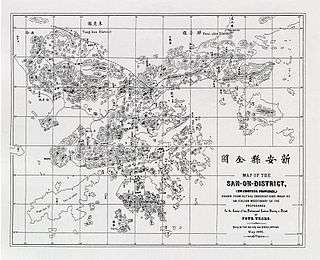Bao'an County
Bao'an County, formerly named Xin'an County, was a historic county in South China. It roughly follows the administrative boundaries of modern-day Hong Kong and the city of Shenzhen. For most of its history, the administrative center of the county was in Nantou.
| Bao'an County 寶安縣 | |||||||||||||
|---|---|---|---|---|---|---|---|---|---|---|---|---|---|
| County of China | |||||||||||||
| 331–1979 | |||||||||||||
| Demonym | Qing China | ||||||||||||
| History | |||||||||||||
• Established | 331 | ||||||||||||
• Disestablished | 1979 | ||||||||||||
| |||||||||||||
| Today part of | People's Republic of China
| ||||||||||||
| Bao'an County | |||||||||||||||||||
|---|---|---|---|---|---|---|---|---|---|---|---|---|---|---|---|---|---|---|---|
| Simplified Chinese | 宝安县 | ||||||||||||||||||
| Traditional Chinese | 寶安縣 | ||||||||||||||||||
| Postal | Poon County | ||||||||||||||||||
| |||||||||||||||||||
| Xin'an County | |||||||||||||||||||
| Simplified Chinese | 新安县 | ||||||||||||||||||
| Traditional Chinese | 新安縣 | ||||||||||||||||||
| Postal | Sunon County | ||||||||||||||||||
| Literal meaning | New peace | ||||||||||||||||||
| |||||||||||||||||||
| This article is part of a series on the |
| History of Hong Kong |
|---|
 |
| Timeline |
| By topic |
|
History
During the Three Kingdoms, the later Bao'an County, along with Dongguan and Boluo counties, formed a single large district with the name Boluo (博羅).[1]
In 331, the Eastern Jin Dynasty established Bao'an County, one of six counties under Dōngguān (東官) Prefecture. This prefecture's area included modern Shenzhen and Dongguan.[2] In the second year of the Zhide of Suzong under the Tang Dynasty (757 AD), Dōngguān was renamed to Dōngguǎn (東莞).

In the 27th year of Hongwu Emperor's (1368–1399, founder of the Ming dynasty) reign, Hongwu appointed an officer with the title Shou-yu-suo (Chinese: 守御所; lit.: 'Protector of the region') to protect the local population from robbers and vagabonds which increasingly infested the district.[1]
In 1573, the first year of the reign of Wanli of the Ming Dynasty, Xin'an County (sometimes referred to as district) was established as a separate administrative division of Guangzhou Prefecture. The area was then separated from the old Dongguan County due to military reasons.[3]
.png)
Under the Qing Dynasty, Xin'an County was one of the fourteen districts under the department of Guangdong. During the Great Clearance (1661–1669), most of Xin'an County was affected by the coastal evacuation. However Xin'an ceased to be a separate administrative county by the 5th year of Kangxi (1666), and the areas not affected by the evacuation were temporarily absorbed into the adjoining Dongguan County until the lift of the ban in 1669.[3] From 1842 to 1898, 1055.61 km2 out of 3076 km2 of Xin'an County was ceded to the United Kingdom to form Hong Kong.[2]
Cession of Hong Kong
The area commonly referred to as Hong Kong was successively ceded or leased from the county to Britain in 1842, 1860 and 1898 under the Treaty of Nanking (Hong Kong Island), Convention of Peking (Kowloon), and Convention for the Extension of Hong Kong Territory (New Territories).
Republic of China era
After the founding of the Republic of China in 1913, the name of Xin'an was changed back to Bao'an.[2]
People's Republic of China era
In 1953, Shenzhen replaced Nantou as the administrative centre, due to the increasing prominence of the town as the southern terminus of the Chinese section of the Kowloon Canton Railway.[4]
In 1979, Bao'an County was renamed Shenzhen City after its county town, and most part of Shenzhen city became a Special Economic Zone a year later.
References
Citations
- Krone 1859.
- Brief History of Shenzhen Archived April 16, 2008, at the Wayback Machine, Shenzhen Government official website.
- James Hayes: "The Hong Kong Region: Its Place in Traditional Chinese Historiography and Principal Events Since the Establishment of Hsin-an County in 1573", in Journal of the Royal Asiatic Society Hong Kong Branch, Vol. 14, 1974. pp.108-135 Archived 2016-02-07 at the Wayback Machine
- 昔日边陲小镇深圳的历史渊源. people.com.cn.
Sources
- Mr. Krone (1859). A Notice of the Sanon District, Transactions, Vol. 6, pp. 71–105, Hong Kong (1859).
Further reading
- O'Donnell, Mary Ann (2001). "BECOMING HONG KONG, RAZING BAOAN, PRESERVING XIN'AN: AN ETHNOGRAPHIC ACCOUNT OF URBANIZATION IN THE SHENZHEN SPECIAL ECONOMIC ZONE". Cultural Studies. 15 (3–4): 419–443. doi:10.1080/095023800110046641. - Published online on 21 October 2010.
.svg.png)